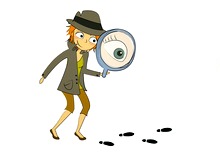| Back to Back Issues Page |
 |
|
English Detective #47: (Quick-)Planning a Listening Lesson; 1-6-15 January 06, 2015 |
The Current Investigation (This issue includes):
Getting the whole story
 This British Council article gives an excellent summary of a standard lesson to help students practice their listening skills.
This British Council article gives an excellent summary of a standard lesson to help students practice their listening skills.
It covers creating interest and providing context, providing tasks to help students listen for gist and again for details, and using post-listening tasks for student reactions or language analysis. Then it demonstrates possible tasks for each stage of a lesson on a song. The author of this blog post on authentic listening tasks suggests a new way to use KWL. (KWL is short for Know/Want to Know/[Have] Learned. Students write, in columns, what they already Know about a topic and what they Want to learn about it before listening to information on that topic, then afterward noting what they have Learned.) Once students have practiced KWL, teachers can use it in specific ways as listening preparation and follow-up when there hasn’t been time to prepare a detailed lesson with pre-learning tasks, questions for gist and details, and vocabulary, etc. The author demonstrates the technique with a video on skateboarding. It looks to me like a potential time-saver, helping students activate their prior knowledge and focus quickly on what they most want to learn. I was fascinated by this NPR interview (as well as the Atlantic article that inspired it.) The interview, in particular, is not too difficult, and it could spark a lively discussion if you have students from different cultures who have come to (or visited) the U.S. It’s about 17 minutes; downloadable, with a transcript available. (However, the transcript varies quite a bit from the actual interview, especially in order of presentation) It’s fairly simple to understand, using mostly common vocabulary. You might want to check if your students understand ‘take for granted,’ ‘punctuality,’‘misconception,’ and ‘uptight.’ (Both the interview and the Atlantic article also use ‘circumspect’ and ‘frankness,’ though I wouldn’t consider them so necessary for understanding.) I would start a listening lesson on it by asking students to volunteer some things that surprised them when they first arrived in the U.S. (I’d list them on the board, to compare to the topics discussed in the interview, then ask them to listen for-- and list-- other topics they hear mentioned.) After they had listened to the interview, I would ask then to discuss in groups whether they generally agreed with the guidebooks’ representation of American culture, and the specific areas in which they agreed or disagreed. If we had time and the class was intermediate or advanced, they might also write individual responses to the interview (and possibly to the Atlantic article or to the article below as well-- or to articles or videos on their own cultures-- if the students were interested in cultural differences and wanted to examine them further.) If your students are interested, you could prolong the discussion of American cultural differences with a similar collection of comments on what surprised people the most when they came to the U.S. Some of the comments are long, but you could reduce class reading time by assigning four of the 16 comments to each of four groups of students. Each group could list observations that were repeated in more than one comment and/or those they agreed with or found most interesting. Then they could share their lists with their classmates. Coming in the next issue: Getting the most from reading texts. P.S. A note if you get gmail: Have you missed any issues of English Detective? if you find English Detective in your Promotions box, you can move it to your Primary box (if you want) by clicking on it and dragging it there, then clicking Yes when asked if you want to always get it in the Primary box. In case you missed these: Earlier issues of English Detective have articles on a number of interesting topics for teachers and for ESL students.You can check them out with the link to the back issues page below. Comments? Ideas? Feedback? I'd love to hear from you. Just reply to this newsletter and tell me what you think! And if you like what you’ve read, why not pass it on to a friend? They can subscribe for themselves here. (It's free!) Also, you can reach me by mail at 1752 Driftwood Drive, El Centro, CA 92243, USA. |
| Back to Back Issues Page |